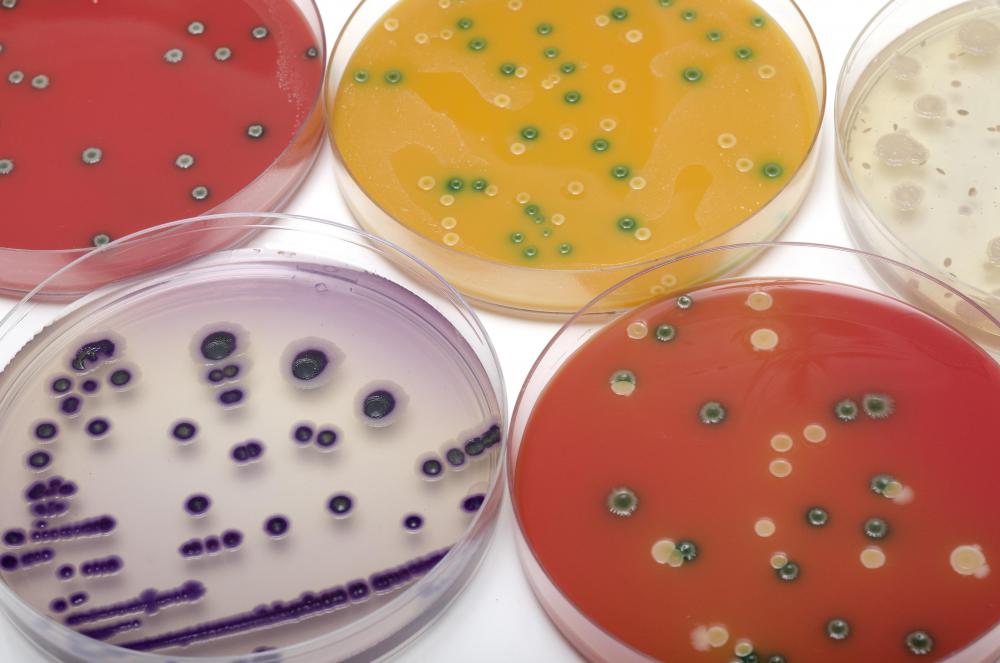At TheHealthBoard, we're committed to delivering accurate, trustworthy information. Our expert-authored content is rigorously fact-checked and sourced from credible authorities. Discover how we uphold the highest standards in providing you with reliable knowledge.
What Is Aerobic Bacteria?
Aerobic bacteria are tiny, single-celled creatures that are one type of germ. Since these bacteria require oxygen to live and grow, this is the defining factor for these tiny organisms. In contrast, bacteria that do not need oxygen, or are even harmed by oxygen, are called anaerobic bacteria.
Cellular respiration is the metabolic process by which aerobic bacteria exchange gases with their environment. This intake of oxygen is vital for digestion and the other energy-consuming process occurring within the bacteria. All animals, including humans, also require the constant presence of oxygen, so humans and these bacteria share the same habitats. Aerobic bacteria are so abundant that they are actually the most numerous and widely distributed organisms on the planet. Where there is adequate oxygen and some form of matter to serve as a food source, aerobic bacteria will likely be present.

One notorious form of aerobic bacteria is Mycobacterium tuberculosis, the organism responsible for tuberculosis. Tuberculosis is the condition that occurs when one or more of the Mycobacterium tuberculosis are breathed in and successfully begin to multiply within the host’s body, particularly in the lungs. Since the tuberculosis bacterium is aerobic, an oxygen lover, the lungs of an individual with a limited immune system make a hospitable habitat. Most healthy people have immune systems that prevent these aerobic bacteria from taking up residence and causing infection.

Not all bacteria are harmful. In fact, many species of bacteria, both aerobic and anaerobic, can actually promote health and prevent disease. These beneficial bacteria can be thought of as a personal army defending their host from more pathogenic organisms. Bacteria are also responsible for the constant breakdown of waste, which returns nutrients to the soil and completes the food chain. In this role, bacteria are classified as decomposers, and their presence in soil is vital to the health of the ecosystem.

Aerobic bacteria reproduce by a process called binary fission, which means one can duplicate itself and split into two identical individuals. It is this ability to rapidly reproduce without having to look for a suitable mate that make bacteria responsible for many dreadful infections. A single, tiny bacterium can enter a wound or be breathed in, and if conditions are right, number in the millions within hours. It is actually the waste generated by bacteria that act as a poison and damage the tissues of the infected person or animal, and not the bacteria themselves.
AS FEATURED ON:
AS FEATURED ON:

















Discussion Comments
I bought a vacuum sealer and it says not to use onions because it might cause anaerobic bacteria. I did a few and put them in the freezer instantly. Are they safe to use or should I toss them?
@hamje32 - There are good and bad bacteria as the article points out. When I lived in Asia I used to drink this yogurt drink product that came in tiny cans.
I was told that it contained beneficial bacteria and that it was good for the stomach and intestines. It tasted OK, a bit like sour milk and yogurt blended together.
Over in Asia they drink that stuff constantly because there is a lot of sickness and disease in the air and so they were constantly on the offensive. Here I suppose regular yogurt would do just as well, in addition to a diet that boosts the immune system.
This is a good explanation of the differences between anaerobic and aerobic bacteria. However, there is one area that has not been discussed.
Anaerobic bacteria are responsible for that hideous disease known as halitosis. That’s because the purpose of the bacteria is to break down food into waste.
In the process of the breakdown they release those odors that we have all come to know and hate. So the most common advice given to bad breath sufferers is to drink a lot of water.
Why is that? It’s because water contains oxygen, and anaerobic bacteria cannot live in an oxygenated environment. Water will you do more wonders for you than mouthwash. Most mouthwash is alcohol based, which will dry out your mouth; this is not the condition that you want.
Post your comments